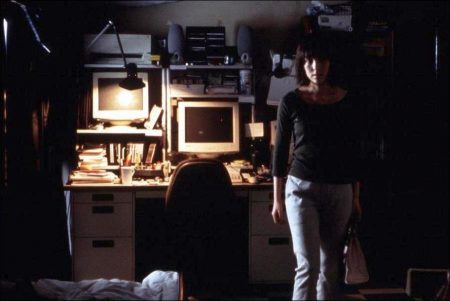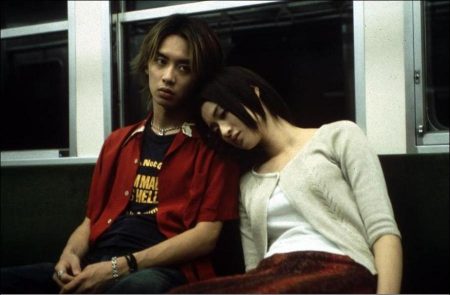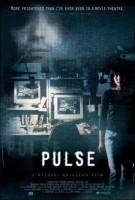Pulse movie storyline. After one of their friends commits suicide, strange things begin happening to a group of young Tokyo residents. One of them sees visions of his dead friend in the shadows on the wall, while another’s computer keeps showing strange, ghostly images. Is their friend trying to contact them from beyond the grave, or is there something much more sinister going on?
Kiyoshi Kurosawa’s “Kairo” has to be one of the most mesmerizing supernatural horror films ever seen. The film is loaded with extremely dark and brooding atmosphere and some scenes actually scared. The photography by Junichiro Hayashi is truly beautiful and the score is very haunting. The theme of “Kairo” is that at the end of the line there isn’t anything except a fearful nothingness-no heaven or hell, just a miserable eternity of living in between states.
The film is cold and bleak, even nihilistic in its portrayal of total isolation. “Kairo” is pretty slow-moving and there is absolutely no gore, so fans of “Scream” or similar crap will be disappointed. Still the visuals are amazing:dark skies, deserted streets and crawling shadows will leave you stunned.A must-see for fans of Japanese horror.
Film Review for Pulse – Kairo
Despite its final upbeat note, the lasting impression left by Pulse is not one of hope but, rather, of humanity’s inability to stem society’s swelling tide of physical, emotional, and psychological estrangement.
Following on the heels of Hideo Nakata’s original Ringu and Takashi Shimizu’s Ju-On, Kiyoshi Kurosawa’s 2001 masterpiece Pulse is, at first glance, simply J-horror film obsessed with the dangers posed by technology.
Yet though the Internet becomes the conduit for otherworldly forces exerting their influence over the living, Kurosawa’s film, largely forgoing traditional scare tactics in favor of a mood of dawning irrational terror, shares little with its Japanese contemporaries save for some aesthetic similarities (an austere color palette, measured pacing, long-haired female ghouls).
As with his similarly magnificent serial killer saga Cure, Kurosawa assumes the superficial trappings of a genre only to utilize them for a philosophical inquiry into the disaffection and loneliness of modern existence. And with this tale of online-fostered apocalyptic alienation, the iconoclastic writer/director eerily pinpoints the means by which technological tools designed to foster greater interconnectedness instead – through encouraging depersonalized, anonymous interfacing with others – merely contribute to greater societal isolation.
Communication breakdown is Pulse’s primary preoccupation, an infectious ailment that spreads throughout Tokyo like a plague – or, more aptly, like a computer virus, as a program on botanical nursery worker Taguchi’s (Kenji Mizuhashi) floppy disk seems to spark a chain of catastrophic web-based events involving forlorn ghosts. When Taguchi goes missing from work, colleague Michi (Kumiko Aso) visits his apartment, where a disheveled Taguchi – when his guest’s back is turned – uses a rope for fatal purposes.
Examining the disk her friend had been working on, Michi and friend Junco (Kurume Arisaka) discover a haunting image of Taguchi’s flat in which a computer screen projects the identical scene they’re looking at, as well as a shadowy spectre staring into another monitor. Not long afterwards, Michi’s television goes haywire (while a newsman discusses a long-lost communiqué) while her other co-worker Yabe (Masatoshi Matsuo), after receiving anonymous phone calls from someone pleading “Help me,” unlocks a mysterious room whose doors are sealed with red duct tape. And in a concurrent storyline, technophobic economics student Kawashima (Haruhiko Kato) teams up with a computer lab worker named Harue (Koyuki) after stumbling upon a strange website called The Forbidden Room which depicts fuzzy people somnolently moving about their tiny abodes.
“People don’t really connect… We all live totally separately,” Harue despondently tells Kawashima after showing him a grad student’s PC project involving tiny dots floating around a black screen, the blips “dying” if they get too close to each other or drawn together if they move too far apart. In a theme that runs throughout Pulse, the program is “a miniature model of our world” because it embodies the simultaneous desire for – and impossibility of – togetherness, in a culture beset by intermediary machinery like cell phones and modems, devices which further trap us in the self-contained prisons of our own selves.
As people begin inexplicably disappearing (or plummeting off industrial buildings), leaving behind body-shaped smudges on the wall or floor, Michi and Kawashima attempt to maintain their flesh-and-blood states amidst a metropolis increasingly populated only by the dead, but Kurosawa’s fuzzy narrative posits no easy answers to the supernatural events engulfing the city. Has the spirit realm become so full that the deceased are now spilling into our reality? Or are the living simply so disconnected from one another that they’ve now transformed into entities cut off from their corporeal vessels? In other words, this is not FearDotCom.
Starting with the image of a ship situated in the vast blue ocean, Kurosawa uses medium and long shots, extended takes, and a disquieting silence (punctuated by unnerving buzzes, blips and humming) to convey the empty, soul-draining seclusion of a world bereft of person-to-person interaction. When married to a preference for unsettling focus shifts – such as in scenes of Michi or Yabe riding a commuter bus, the outside scenery lost in a haze of ominous indistinctness – the director generates dread-filled anxiety by suggesting that unknown horrific sights lie in wait just outside his tranquil frame.
At no moment does Pulse provide a jolting scare that might somehow ease the amplifying tension, and yet the all-encompassing atmosphere of gloom and doom creeps under one’s skin with sinister subtlety until, with the plot having long since veered off into semi-incoherence, one’s left stuck with an unshakable vibe of existential hopelessness.
With Michi and Kawashima unwilling to succumb to death’s alluring embrace, the duo eventually wend their way out of their urban wasteland in a final land-and-sea sequence tinged with optimism about mankind’s future prospects for individual and communal unity. Yet despite its final upbeat note, the lasting impression left by Pulse is not one of hope but, rather, of humanity’s inability to stem society’s swelling tide of physical, emotional, and psychological estrangement. — Aka Kairo
Pulse (2005)
Kairo
Directed by: Kiyoshi Kurosawa
Starring: Haruhiko Katô, Kumiko Asô, Koyuki, Kurume Arisaka, Masatoshi Matsuo, Shinji Takeda, Jun Fubuki, Shun Sugata, Shô Aikawa, Kôji Yakusho, Kenji Mizuhashi
Screenplay by: Kiyoshi Kurosawa
Production Design by: Tomoyuki Maruo
Cinematography by: Jun’ichirô Hayashi
Film Editing by: Jun’ichi Kikuchi
Makeup Department: Yûichi Matsui
Art Department: Yoshihisa Kato
Music by: Takefumi Haketa
MPAA Rating: R for some violent images.
Distributed by: Magnolia Pictures
Release Date: November 9, 2005
Views: 76





